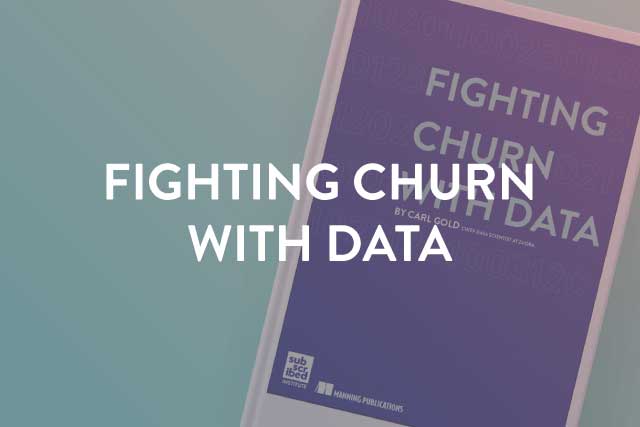During the coronavirus pandemic, many businesses moved into crisis mode to keep homebound workers connected remotely. Providing uninterrupted customer service became a matter of business survival.
“It’s more important than ever that businesses use this time to provide value and ultimately strengthen their relationships with customers,” said Carl Gold, chief data scientist at subscription software company Zuora.
In the words of his company’s CEO, Tien Tzuo, “It’s time to double down on relationships.” More than ever, businesses have what they need to build strong relationships: customer data.
Shift to Subscription is a series by The Forecast exploring the rise of subscription business models.
“Data is gold,” said Gold, author of Fighting Churn with Data, a book about how to harness customer data to create business value and profit. "The data sitting unused in a typical company data warehouse can provide even more information than a detailed survey of your customers.”
Set to publish this summer, Fighting Churn with Data examines how subscription-based companies can use customer data to maintain and grow recurring revenue. It explores “churn rate,” which refers to the proportion of total subscribers who leave a service during a given time period. The book offers business leaders best practices and pitfalls to avoid.
Subscription Growth Shines Spotlight on Churn
Managing churn is a critical factor for subscription-based business, including companies like Adobe, Netflix and Nutanix. Since it started shifting to a subscription business model in 2018, enterprise cloud software company Nutanix has seen a significant increase in the portion of its revenue that comes from subscription vs. traditional buyers. It is also likely to help better predict recurring revenue, which is directly tied to customer churn.

According to Zuora, the subscription economy has grown by more than 350 percent over the past 7.5 years. Businesses and their customers can each benefit from a subscription model. Buyers can pay as they go rather than pay in full upfront, and businesses can better predict quarterly revenue. A bedrock of this model: customers are free to continue or stop their subscription. Therefore, subscription service providers need data analytics tools to learn about what makes customers tick so they can entice them to stay.

Gold wants to help other data scientists benefit from the five years he spent analyzing customer data for more than 1,000 companies. The Cal Tech Ph.D. and former Wall Street quantitative analyst wrote Fighting Churn for tech geeks who enjoy creating software code to extract value from raw data, especially for those leading subscription businesses, which need to sell more to existing customers or add new subscribers to grow.
“When customers leave, it can lead to contraction,” said Gold. “Many services focus on customer acquisition initially, but to be successful in the long run, a service must also work to reduce churn.”
Creating and executing a data-driven strategy is essential, according to Gold. To retain subscribers, business leaders must break down silos to create an integrated data foundation. They can start by combining different data sources into one analysis.
“You make a set of customer metrics, where every metric is predictive of churn and retention and enables you to diagnose customer health,” he said. “Those metrics become a source of alignment across different teams.”
[Related story: Why the Subscription Model Is Our Future]
This information can help product creators, marketing and customer support make fast decisions that keep people from hitting the unsubscribe button.
Gold said it’s not necessary to wait until there’s a large pool of customer data. Even small amounts of data can help reduce churn.
“The ‘bigness’ of the data is a red herring,” he said. “We work with a lot of companies whose data is technically small, but they still extract enormous value from it.”
No One Size Fits All Approach for Fighting Churn
Gold said data scientists can help a cloud-based company learn about consumption behaviors, like “how much [customers are] using [a given resource] according to the key metrics such as gigabytes of data, compute time, or what have you.”

These insights can help a company to change its customer services to being more proactive. For example, at enterprise cloud software company Nutanix, which started to shift to a subscription business model in 2018.
“The data from our machines can help us figure out when a customer’s going to run out of capacity,” said Parag Kulkarni, Nutanix’s Vice President for SaaS engineering. He said that kind of predictive insight can help customers avoid data system downtime by alerting them before it’s time to add more hardware or allocate more resources to the cloud. “If we know what could happen, then we can be truly predictive and proactive about support, instead of being purely reactive to support requests.”
[Related story: Built-In Customer Experience Analytics Boost ROI]
Analyzing and acting on data in this way can improve the customer experience (CX). This can help maintain subscribers and encourage them to buy more services. Or, more simply, churn can be understood through a “a continuous survey of your customers as they sample the features of your service,” said Gold. This is when they decide to stay or unsubscribe.
Providing value and flexibility to customers is critical. Offering customers the option to suspend and resume their subscription can save one in six customers from leaving, according to Gold.
He hopes Fighting Churn helps businesses look at churn in new ways.
“Churn is an incredible metric that can help companies – regardless of industry and size – to iterate their offerings and innovate in ways they never believed possible,” Gold said. “All with the goal of providing value to customers and retaining them in the long run.”
Try Nutanix Frame Desktop-as-a-Service free for 30 days.
Charlotte Jensen is a contributing writer who specializes in business topics. She is the former executive editor of award-winning Entrepreneur magazine. Find her on Twitter @JensenChar.
© 2020 Nutanix, Inc. All rights reserved. For additional legal information, please go here.


